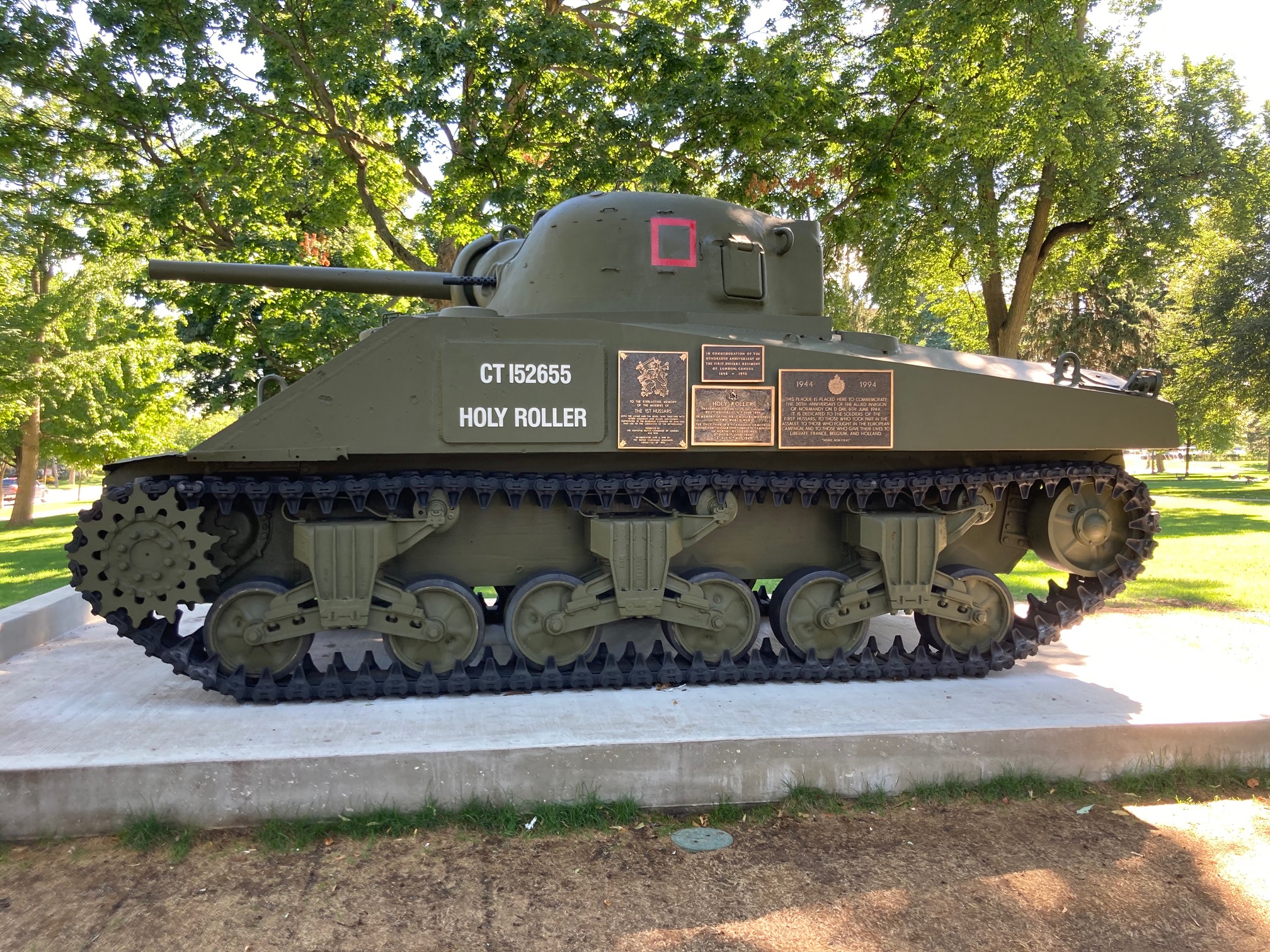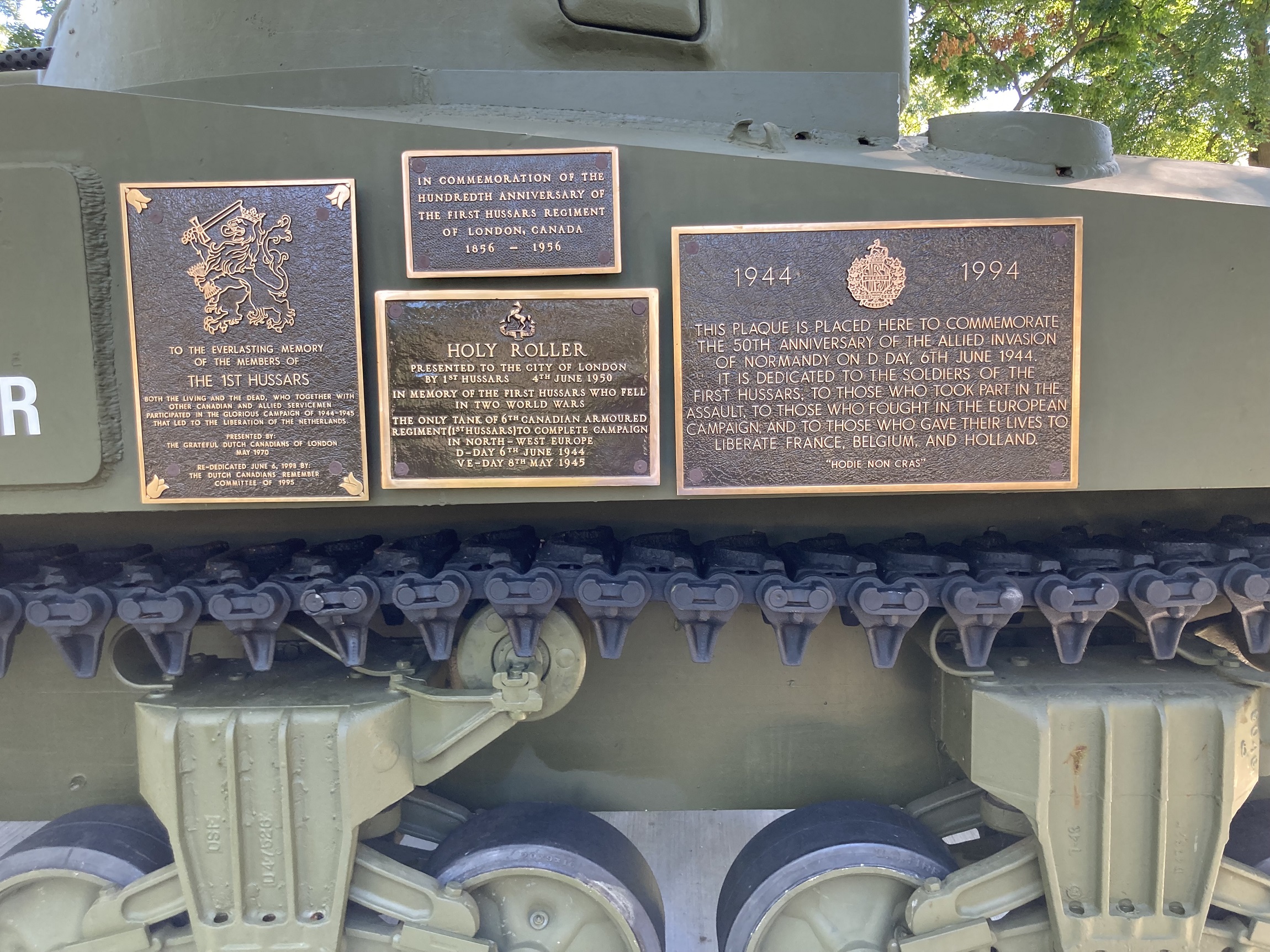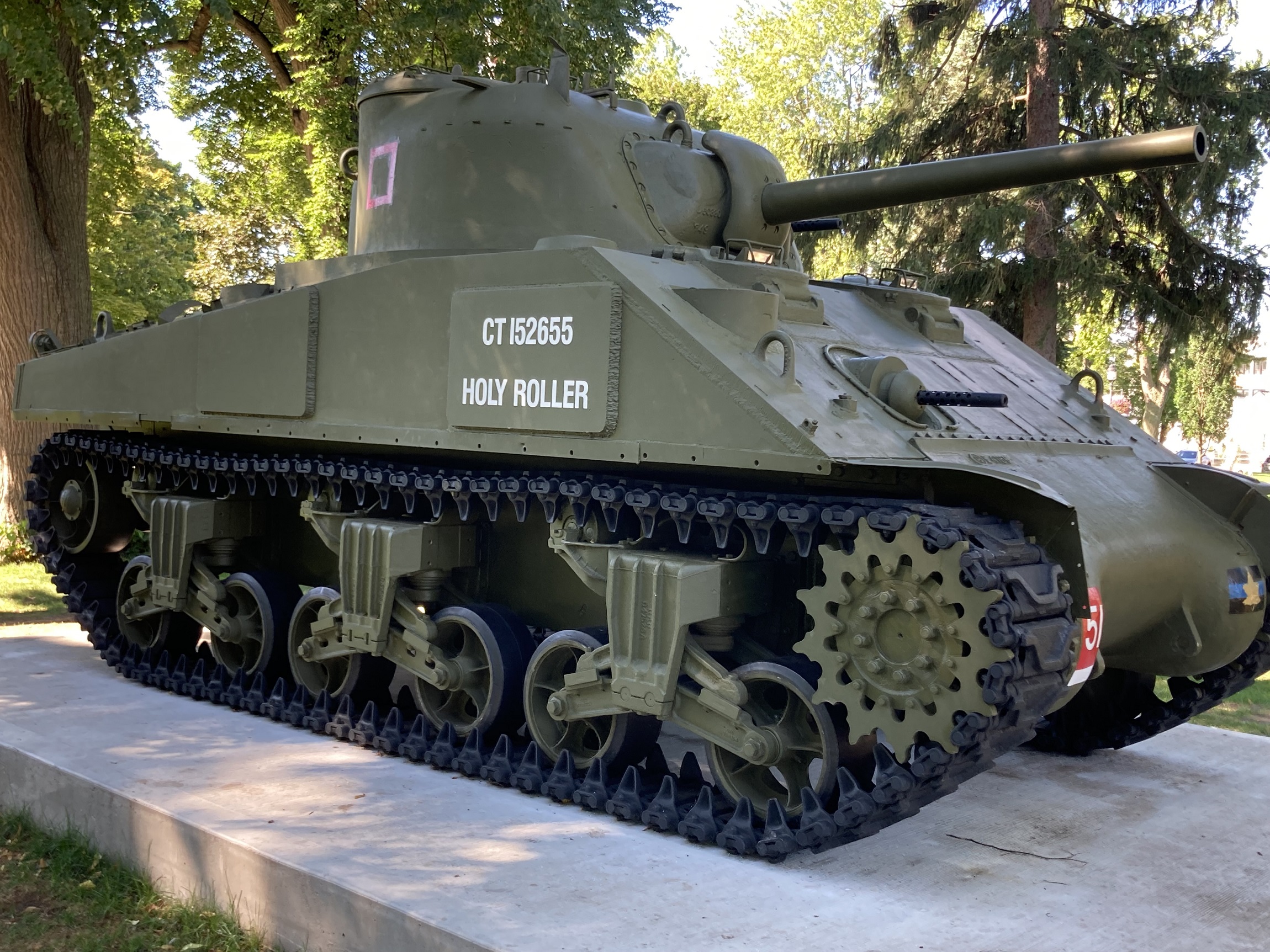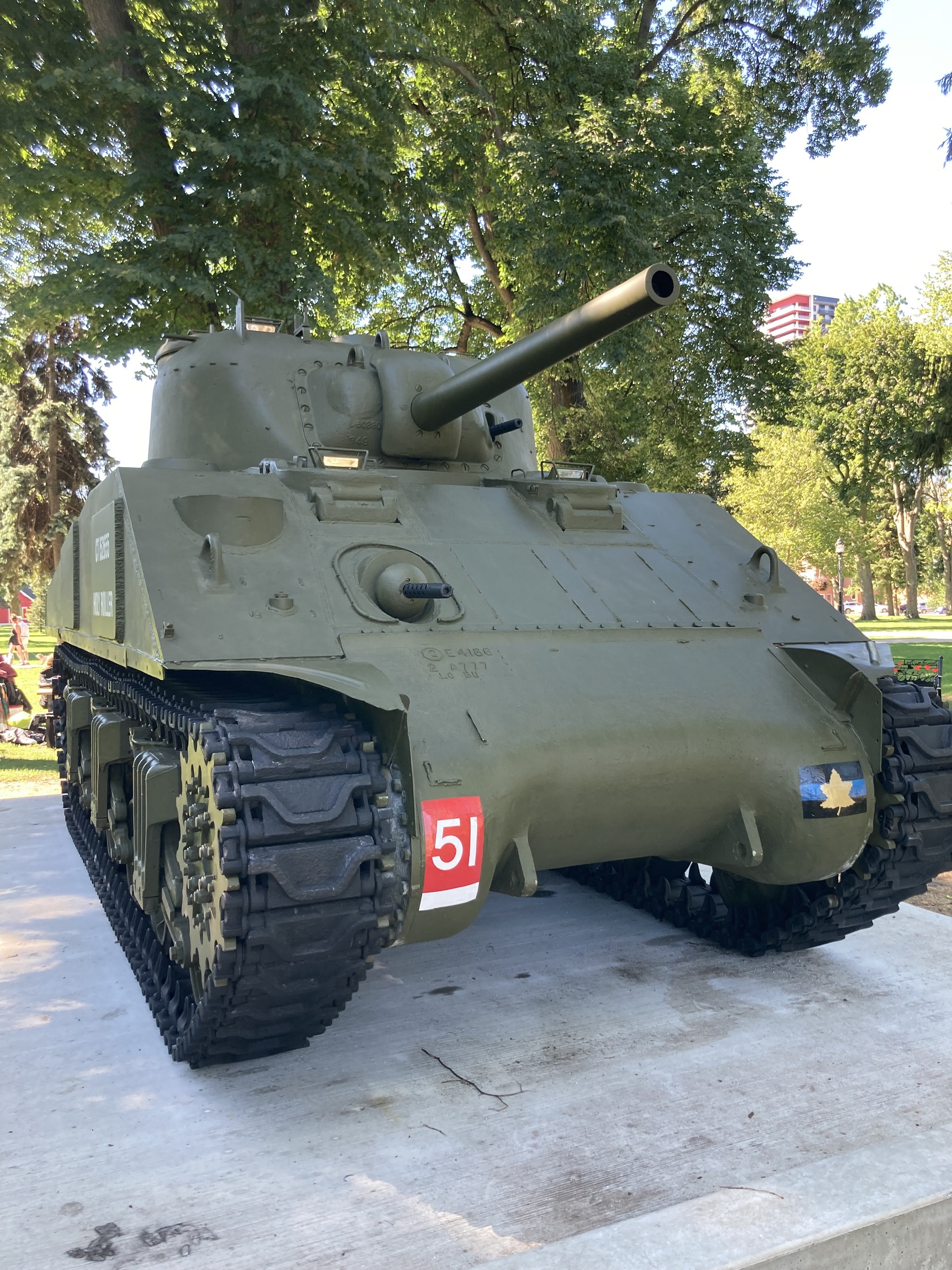1st Hussars Memorial
Municipality/Province: London, ON
Memorial number: 35042-005
Type: Vehicle - Sherman III (M4A2) tank
Address: 580 Clarence Street
Location: Victoria Park
GPS coordinates: Lat: 42.9903833 Long: -81.2494633
Submitted by: Harry Palmer. Richard Turcotte. 1st Hussars Museum. Steve Hearn.
This memorial was dedicated on 4 June 1950 to the members of the 1st Hussars who died in the Second World War. In 1945, HOLY ROLLER was designated by military authorities as a vehicle with significant historical and sentimental value to the 1st Hussars and as such was authorized to be returned to Canada as a regimental trophy.
HOLY ROLLER is the only tank of the 1st Hussars and one of only two Canadian Army Sherman tanks to have survived the Second World War from D-Day, 6 June 1944, to VE-Day 8 May 1945. During that time the 1st Hussars lost 346 tanks. HOLY ROLLER landed on Juno Beach just 20 minutes behind the initial assault wave. The other tank, named Bomb, was operated by The Sherbrooke Hussars and is on display at William Street Armoury in Sherbrooke, Quebec.
Plaques added to the memorial include the 100th Anniversary of the First Hussars Plaque, the 1st Hussars Liberation of Netherlands Plaque (placed by the Dutch Canadians Remember Committee) and the 1st Hussars 50th Anniversary of D-Day Plaque.
In May 2017, the city unsealed the tank for the first time since its dedication to assess its state of repair. The Sherman III (M4A2) tank, HOLY ROLLER, was moved from Victoria Park to Fanshawe College on 8 June 2021 to undergo significant repair and preservation work. The work amounted to more than 10,000 hours undertaken by a group of dedicated volunteers with more than 1,000 additional hours of technical and material support from many local businesses. More than $200,000 was raised mainly through individual and group donations with additional grants from the Federal government. Some scarce components used during the repair work had to be sourced in Belgium and France. HOLY ROLLER was returned to Victoria Park on 31 May 2022 and rededicated on 5 June 2022.
On the right of the hull is the unit identifier - a white 51 on a red square that was assigned to the 1st Hussars. Their official title during the war was 6th Canadian Armoured Regiment (1st Hussars), but the unit always referred to themselves as 1st Hussars. The white bar under the red square indicates they were part of an independent Armoured Brigade. The hollow red square on the turret indicates that HOLY ROLLER was a vehicle belonging to B-Squadron. The colour red indicates that the 1st Hussars were the senior regiment out of 3 in the 2nd Armoured Brigade. Holly Roller landed on D-Day as part of the Regimental Headquarters and up until the middle of June 1944 had a red diamond in place of the square. After the disastrous battle of Le Mesnil-Patry on 11 June it was moved to B-Squadron as the commanding officer’s tank during the reorganization of the regiment and remained there for the rest of the war.
The marking on the left of the hull with the maple leaf is the unit identifier for the 2nd Canadian Armoured Brigade which the regiment was part of.
HOLY ROLLER is an early version of American Medium tank M4A2, known as a Sherman III in British and Commonwealth service. It was built at Fisher Tank Arsenal in Grand Blanc, Michigan, during the last week of September 1942 and in late 1943 underwent a series of modifications at the Lima Tank Depot in Ohio to incorporate several improvements that resulted from battlefield experience. These included additional applique armour over the hull ammunition racks.
HOLY ROLLER was issued new to the 1st Hussars in May of 1944 just weeks prior to departing for France. Under the command of Major Frank White Second in Command of the Regiment (2ic) it landed on Juno Beach 20 minutes behind the first assault wave. Shortly after it was taken over by Regimental Commander Lieutenant Colonel Ray Colwell when his tank was disabled by a mine as it moved off the beach. HOLY ROLLER proceeded inland approximately seven miles to the Regiment’s first harbour in France at Pierrepont before being sidelined with a broken fuel line. Repaired overnight HOLY ROLLER remained in the thick of the action during the intense battle for the beachhead. On June 8 in what has been described as one of the epic battles of the beachhead, HOLY ROLLER, again under the command of the Regimental 2ic Major Frank White, lead the 1st Hussars in support of the Canadian Scottish Regiment during the recapture of Putot-en-Bessin which had been lost earlier that day to a German counter attack. Positioned on the right flank of the attack the Hussars found themselves often engaging enemy targets over the heads of the infantry while eliminating several machine gun and mortar positions.
On June 11, the Regiment attacked the Germans at Le Mesnil-Patry. HOLY ROLLER, commanded by Major White, was with the Regimental Headquarters a short distance behind the leading squadrons at Norrey-en-Bessin which was under heavy artillery and mortar fire for the entire battle. The Germans handed the 1st Hussars a crushing defeat that day and as the lead squadrons retreated, Major White in HOLY ROLLER, organized a defensive position using the surviving tanks of C Squadron and a troop from A Squadron to cover the withdrawal and block the anticipated German Counter attack. In the reorganization following the battle, HOLY ROLLER was sent to B Squadron as the Squadron Commander’s vehicle and here it remained for the rest of the war.
During the next ten months HOLY ROLLER was hit four times by enemy fire and although damaged protected the crew and remained in the fight. The first hit likely occurred on July 18 in the fighting around Caen with a direct hit on the glacis plate which was fortunately deflected by a section of track welded to the hull as additional armour. This hit required the main gun to be replaced, but it was soon back in action. B Squadron and HOLY ROLLER were in the thick of the fighting and often leading. The second hit probably occurred on July 26 near May-sur-Orne where the B Squadron Commander was wounded. This time the track welded to the hull as additional armour was blown completely off, but both tank and crew survived to fight on. The next day B & C Squadrons were combined due to the heavy losses of the previous day. The third hit in less than a month occurred in the fighting around Bretteville-sur-Laize on August 9. Squadron Commander Major JW Powell was wounded and once again HOLY ROLLER was saved by the add on armour. In September, B Squadron and HOLY ROLLER participated in the capture of the huge cross channel guns at Cape Gris Nez and Calais under truly appalling conditions.
After traveling an almost record 1500 miles the clutches needed to be replaced. The tank was next engaged at the end of October when the 1st Hussars assisted the Polish Armoured Division in the capture of Breda in Holland. The next action took place in mid-January when both A & B Squadrons were dispatched to aid a British unit in clearing the Germans out of Hemmen Castle and the town of Zetten near Nijmegen Holland. Here for the first time the Hussars were engaged in supporting the infantry in a built-up area and were subjected to intense anti-tank, sniper, and bazooka fire at close range. HOLY ROLLER came through needing no more than new injectors for the engines. On February 8 the tank was in action as B Squadron fired over 1000 rounds in support of Operation Veritable, the allied attack into the Reichswald and Siegfried Line.
Later in February and early March HOLY ROLLER took part in Operation Blockbuster the final drive to the Rhine. During the 9-day period from February 26 through March 7, 1945 the 1st Hussars with a normal strength of 61 tanks lost 82 Shermans. On the final day, the Regiment could muster only 17 operational tanks. HOLY ROLLER answered the call and its next major action was almost the last. Advancing on Apeldoorn Holland, it was hit by an 88mm anti-tank gun and this time luck ran out. The hit knocked out several suspension components on one side rendering the tank immobile. In the words of the Regimental Commander Lieutenant Colonel Frank White “Tanks had been abandoned for less, but HOLY ROLLER was a legend by now and had to be saved”. In a very unusual move, six 1500-pound suspension units were brought forward and installed in record time by members of the Unit’s echelon and #54 Light Aid Detachment attached to the unit under the command of Captain Proctor Neil. The end of the war found HOLY ROLLER at Godensholt Germany. It had advanced some 2500 miles, participated in 14 major Battles, and out lasted 346 other tanks.
By mid-September 1945, HOLY ROLLER was designated for return to Canada. It left Antwerp, Belgium on 17 March 1946 aboard the SS Hamstead Park. A brief stop in Camp Borden placed the tank in like new condition. It arrived in London and was displayed in front of the Armouries in June of 1946. In 1949, HOLY ROLLER was turned over to the City of London and placed in Queens Park as a war memorial. As part of the Regiment’s 100th Anniversary celebrations in 1956, the tank was moved to its current location in Victoria Park.
Inscription found on memorial
[left side/côté gauche]
CT 152655
HOLY ROLLER
(plaque)
TO THE EVERLASTING MEMORY
OF THE MEMBERS OF
THE 1ST HUSSARS
BOTH THE LIVING AND THE DEAD, WHO TOGETHER WITH
OTHER ALLIED CANADIAN AND ALLIED SERVICEMEN
PARTICIPATED IN THE GLORIOUS CAMPAIGN OF 1944-1945
THE LED TO THE LIBERATION OF THE NETHERLANDS
PRESENTED BY:
THE GRATEFUL DUTCH CANADIANS OF LONDON
MAY 1970
RE-DEDICATED JUNE 6, 1998 BY:
THE DUTCH CANADIANS REMEMBER
COMMITTEE OF 1995
(plaque)
IN COMMEMORATION OF THE
HUNDREDTH ANNIVERSARY OF
THE FIRST HUSSARS REGIMENT
OF LONDON, CANADA
1856 - 1956
(plaque)
HOLY ROLLER
PRESENTED TO THE CITY OF LONDON
BY 1st HUSSARS 4th JUNE 1950
IN MEMORY OF THE FIRST HUSSARS WHO FELL
IN TWO WORLD WARS
THE ONLY TANK OF THE 6th CANADIAN ARMOURED
REGIMENT (1st HUSSARS) TO COMPLETE CAMPAIGN
IN NORTH-WEST EUROPE
D-DAY 6th JUNE 1944
VE-DAY 8th MAY 1945
(plaque)
1944 1994
THIS PLAQUE IS PLACED HERE TO COMMEMORATE
THE 50TH ANNIVERSARY OF THE ALLIED INVASION
OF NORMANDY ON D DAY, 6TH JUNE 1944.
IT IS DEDICATED TO THE SOLDIERS OF THE
FIRST HUSSARS; TO THOSE WHO TOOK PART IN THE
ASSAULT, TO THOSE WHO FOUGHT IN THE EUROPEAN
CAMPAIGN, AND TO THOSE WHO GAVE THEIR LIVES TO
LIBERATE FRANCE, BELGIUM AND HOLLAND.
"HODIE NON CRAS"
[right side/côté droit]
CT 152655
HOLY ROLLER
Street view
Note
This information is provided by contributors and Veterans Affairs Canada makes it available as a service to the public. Veterans Affairs Canada is not responsible for the accuracy, currency or reliability of the information.
- Date modified:



